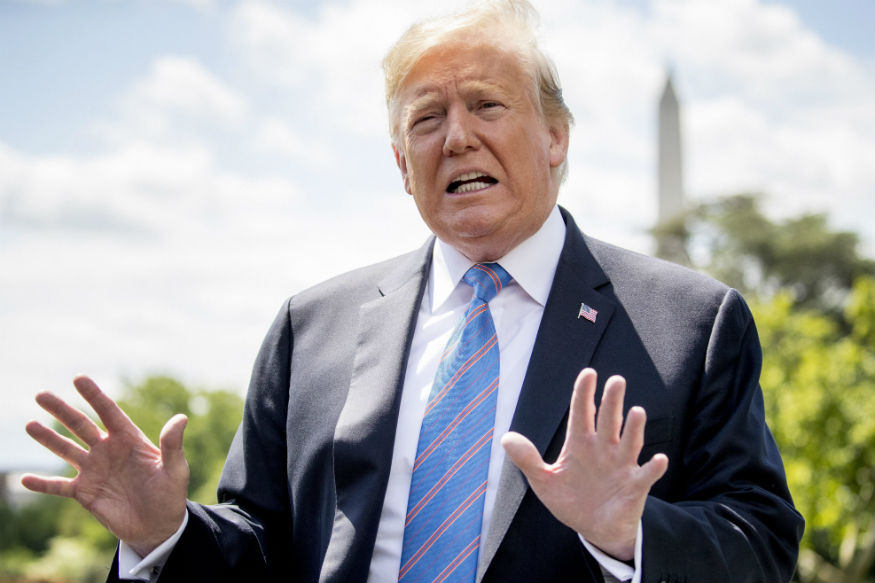According to US media reports on Friday, President Trump approved military strikes against Iran in retaliation for downing an American surveillance drone but pulled back from launching them on Thursday night after a day of escalating tensions. Iran shoots down US military drone
HIGHLIGHTS
- Officials said Trump had initially approved attacks on a handful of Iranian targets, like radar and missile batteries.
- But the action was then abruptly called off.
- The US attack plan was intended as a response to the shooting down of the unmanned, $130 million surveillance drone.
As late as 7 p.m., military and diplomatic officials were expecting a strike, after intense discussions and debate at the White House among the president’s top national security officials and congressional leaders, according to multiple senior administration officials involved in or briefed on the deliberations.
Officials said the president had initially approved attacks on a handful of Iranian targets, like radar and missile batteries.
A senior official said that the operation was underway in its early stages when it was called off. He further added that Planes were in the air and ships were in position, but no missiles had been fired when word came to stand down.
The Washington Post and ABC News also reported the developments, citing unnamed White House officials and other sources said to be familiar with the matter.
The White House declined to comment on the reports.
The abrupt reversal put a halt to what would have been the president’s third military action against targets in the Middle East. Mr. Trump had struck twice at targets in Syria, in 2017 and 2018.
It was not clear whether Mr. Trump simply changed his mind on the strikes or whether the administration altered course because of logistics or strategy. It was also not clear whether the attacks might still go forward.
The developments came just hours after Iran’s elite Islamic Revolutionary Guard Corps (IRGC) said it shot down an unmanned US aircraft after it flew into Iranian airspace.
The IRGC said the unit was downed by a surface-to-air missile, marking the first direct Iranian-claimed attack on US assets amid heightened tensions between Washington and Tehran unleashed by Trump’s decision last year to withdraw from an international accord that curbed Tehran’s nuclear programme.
Since then, the US has deployed more military assets to the Gulf, as well as thousands of more troops.
Speaking later on Thursday, US officials said the drone was in the international territory at the time it was brought down. Trump separately told reporters “Iran made a big mistake” and his “country will not stand for it”, before later suggesting the move may have been unintentional.
When asked if he would respond militarily, Trump said, “You’ll soon find out.”
On Friday, Iran’s foreign ministry said Tehran had “indisputable” evidence that the aircraft violated its airspace.
Deputy Foreign Minister Abbas Araghchi told Swiss Ambassador Markus Leitner, “Even some parts of the drone’s wreckage has been retrieved from Iran’s territorial waters.”
Iranian Foreign Minister Mohammad Javad Zarif gave the exact coordinates where he said the drone was shot down, adding Iran has retrieved sections of the unmanned aerial vehicle from its territorial waters.
Majid Takht Ravanchi, Iran’s ambassador to the United Nations, sent a letter to Secretary-General Antonio Guterres on Thursday denouncing the incident as a “blatant violation of international law”.
“While the Islamic Republic of Iran does not seek war, it reserves its inherent right … to take all appropriate necessary measures against any hostile act violating its territory, and is determined to vigorously defend its land, sea, and air,” Ravanchi said.
Iran’s Defence Minister Amir Hatami said on Friday, “Very complicated and suspicious conditions exist in the region,” “It seems that all of this is in line with an overall policy for creating Iran phobia and creating a consensus against the Islamic Republic.”
The escalation of words and actions has raised fears that a miscalculation or a further rise in friction could push the US and Iran into open conflict.
The US Federal Aviation Administration (FAA) issued an emergency notice barring US airlines from flying in airspace over parts of the Gulf because of the “heightened military activities and increased political tensions”.
Analysts, meanwhile, warned the downing of the drone and its subsequent fallout could result in a major conflict erupting in the region.
“This is a 1914 moment in the region – a single incident can result into a catastrophic clash in the region,” Ali Vaez, Iran project director for the Belgium-based International Crisis Group, told Al Jazeera.
“That would not just involve the Iranians and the Americans, but the entire region would be put on fire,” Vaez added.
Prince Khalid bin Salman, Saudi’s deputy defence minister, said in a tweet that he had discussed the latest “Iranian attacks” with US envoy for Iran Brian Hook during a meeting between the pair.
“We affirmed the kingdom’s support, which came as a result of continuing Iranian hostility and terrorism,” bin Salman said. He added the pair had explored “the latest efforts to counter hostile Iranian acts and continuous escalation that threaten the region’s security and stability”.
US House Speaker Nancy Pelosi, meanwhile, told reporters she didn’t think Trump would engage the US in war, saying there was “no appetite” for it among Americans.
“It’s a dangerous situation. The high-tension wires are up in the region. We have to be strong and strategic about how we protect our interests. We also cannot be reckless in what we do,” Pelosi said.
Both the United States and Iran identified the aircraft as an RQ-4 Global Hawk, a surveillance drone made by Northrop Grumman.
“This was a show of force — their equivalent of an inside pitch,” said Derek Chollet, a former assistant secretary of defense for international security affairs during the Obama administration, speaking of Iran’s decision to shoot down the drone.

Leave a Reply